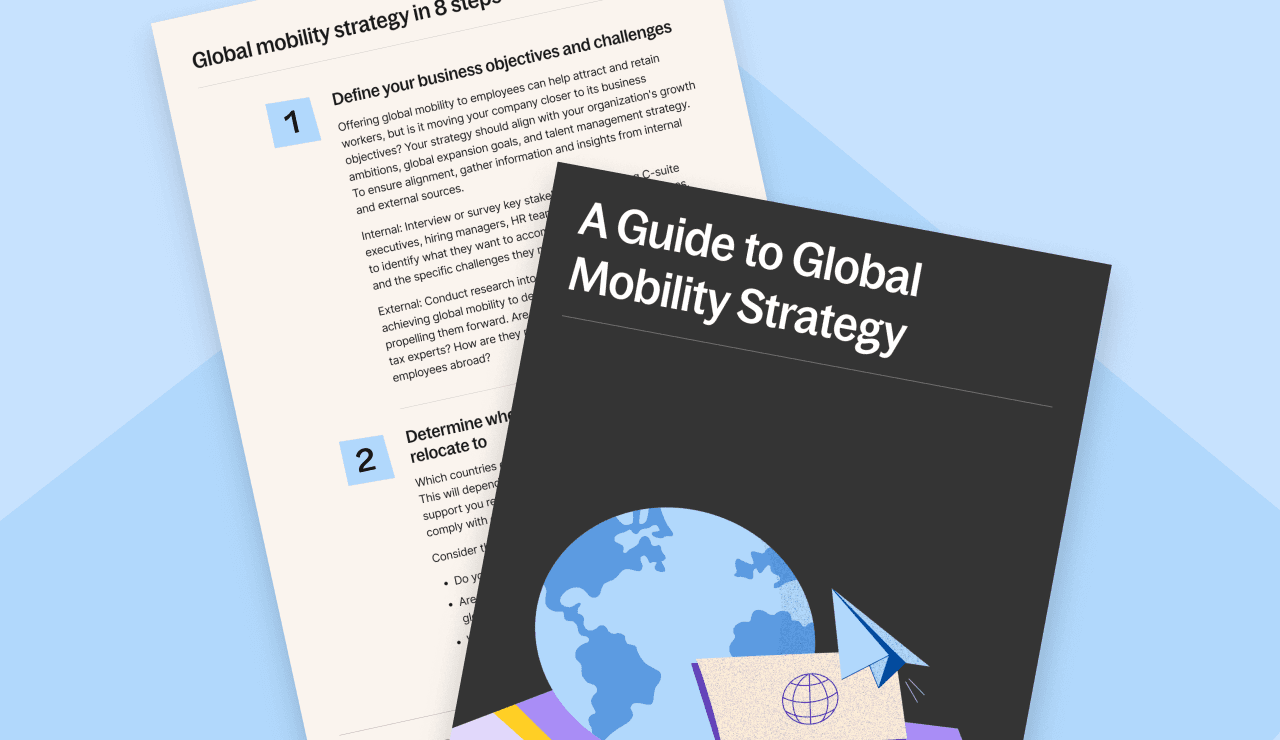Template
Free Employee Relocation Policy Template
Immigration

Get the resource for free
Key takeaways
- Companies should support global mobility to compete globally, providing employees with the opportunity, freedom, and flexibility of international relocation for professional and personal reasons.
- An employee relocation policy provides companies with a formal process for requesting, approving, and managing employee relocation to ensure the relocation is a beneficial experience for the company and employee.
- Deel has created a free employee relocation policy that you can tailor to suit your company's unique preferences and goals.
How to use this template
This template is a customizable document. You’ll see placeholder text and prompts to guide your policy to reflect your company’s unique approach to employee relocations.
We suggest including this policy in your onboarding process to ensure new employees review and understand all details of your relocation program and ensure a smooth relocation experience.
Who will benefit from this policy?
An employee relocation policy is essential for businesses and their HR departments looking to craft a clear and comprehensive employee relocation process.
The policy will provide employees with an understanding of the types of relocations permitted, the eligibility and requirements, any compensation adjustments, the relocation approval process, relocation assistance, relocation cost coverage, and family and pet support.
This template is part of our remote work policy collection, which aims to support growing teams with modern and approachable templates for the future of work.
Discover how Zip Co champions worker mobility with Deel.
When the conflict started in Europe, some of our team members in Ukraine had to relocate. Thanks to Deel, we were able to provide those team members with job security and flexibility, which helped reduce the amount of stress they were feeling at the time.
—Carmen Fan,
Head of Marketing, Floshi
Employee relocation policy template overview
An employee relocation policy is a document that outlines a company’s guidelines on eligibility, requirements, support, procedures, and best practices regarding employee relocation.
This policy is essential for companies looking to fulfill corporate relocation business objectives, such as expanding the company's presence in new locations, exploring new markets, and boosting talent acquisition and retention through supported employee-requested moves.
The policy includes:
- General guidelines regarding employee eligibility and exemptions for short-term and long-term relocation
- Potential purposes for employee relocation, such as expats returning home, traveling for family emergencies, business expansion, growth and learning opportunities, and more
- The procedure and guidelines for requesting relocation
- Guidelines regarding relocation expenses, lump sum relocation allowances, and relocation reimbursements for things like travel and airfare, moving company expenses, house hunting trips, coworking spaces, acquiring new household goods, and other related expenses
- Guidelines regarding other types of company support and relocation benefits within an employee relocation package, such as relocation service providers, home sale assistance for homeowners, temporary housing, childcare, etc.
- Guidelines regarding relocation compliance involving paperwork, work authorizations, permits, and visas for relocating employees
- Guidelines for movers with dependents (family members and pets)
- Employee compensation adjustment guidelines
See also: 10 Fair Employee Compensation Strategies For Global Teams.
Discover how Quantium retained top talent with Deel.
More resources
FAQs
What is an employee relocation policy?
An employee relocation policy is a set of guidelines and procedures established by an organization to govern the process of moving employees from one location to another for personal and work-related reasons.
This policy outlines the terms and conditions under which the company provides assistance and support to employees who need or want to relocate.
What should be included in an employee relocation policy?
Key elements typically covered in an employee relocation policy include:
- Policy summary and purpose
- Relocation types
- Eligibility criteria
- Requirements
- Compensation adjustments
- Relocation request, approval, and assistance
- Cost coverage
- Family/pet support
How does an employer decide who is eligible for relocation?
Employers typically establish eligibility criteria for relocation based on several factors, including company policies, the nature of the job, an employee's role within the organization, length of tenure at the company, and consistently good performance and the specific circumstances of the relocation.
What are the typical components of a relocation package?
For mobility to be an opportunity for employees, your relocation package must go beyond financial aid to ensure employees receive incentives, education, and support.
Here’s what an effective relocation package includes:
- Relocation allowances and expense reimbursements
- Skill workshops and cultural training
- Visa and immigration support
- Flexible cafeteria-style benefits and perks
- Settling in period
💡See also: Employee Mobility & Employee Relocation Packages Explained.
How does a company calculate the cost of relocating an employee?
Calculating the cost of relocating an employee involves assessing various expenses associated with the move and determining which of these expenses the company will cover as part of the relocation package.
If the employee is relocating to accommodate the company’s needs, companies often cover all costs related to travel, documentation, accommodation, and settling-in costs. If the relocation was the employee’s decision, the company might offer no, partial, or full-cost coverage.
Here are some common components that companies typically consider when calculating the cost of relocating an employee:
- Moving expenses: This includes the cost of packing, shipping, and transporting the employee's household goods and personal belongings to the new residence. Companies may hire a professional moving company to handle this process
- Temporary housing: If the employee needs temporary housing while they search for a permanent residence in the new location, factor in the cost of lodging, rent, or hotel accommodations
- Travel costs: Expenses related to the employee's travel to the new location, such as airfare, train tickets, or gas for a personal vehicle, are considered. Costs for the employee and their family members, if applicable, may be included
- Home sale or purchase assistance: If the employee is selling their current home or purchasing a new one, the company may offer assistance with real estate agent fees, closing costs, or other expenses related to the transaction
- Rental assistance: For renters, the company may cover expenses like lease termination fees, security deposits, or the cost of breaking a lease
- Spousal or partner employment assistance: Some companies provide support for the spouse or partner of the relocating employee in finding new employment in the destination location. This can include job placement services or networking assistance
- Tax gross-up: Employers may "gross-up" the employee's relocation package to cover the tax implications of receiving certain benefits. This ensures that the employee doesn't incur additional taxes on the relocation benefits provided
- Miscellaneous expenses: Other costs that may be considered include visa or immigration fees, pet transportation, storage of household goods, and any special requirements or requests made by the employee
💡See also: A Guide to EOR-Sponsored Visas for Enterprise Businesses.
"Some relocations take time for a variety of reasons (immigration, housing needs, pandemic, etc.). The candidate may want to work remotely until the move happens. If they are working in a country where their employer does not have an entity, they can be employed on an EOR until the relocation happens." — Steve Hoffman, Senior Strategic Partnerships Manager
Are there any legal requirements for employee relocation policies?
Employers should be aware of several legal and compliance considerations when developing and implementing employee relocation policies. Here are some key legal aspects to consider:
- Compliant hiring: When an employee spends a certain number of days in a new country or jurisdiction or establishes a new home there, they may trigger local tax obligations. In these circumstances, the employer must modify the employment arrangement to update the employee's tax residency and comply with local labor law, including statutory benefits and payroll. The company may need to officially hire the employee in the new country through a local entity or an employer of record (EOR) arrangement
- Immigration laws: If the relocation involves international moves or employees from different countries, employers need to comply with immigration laws and may need to secure work authorizations, visas, or permits for their employees
- Contractual obligations: If an employment contract or offer letter includes relocation terms and conditions, the employer is generally legally obligated to fulfill those contractual obligations. Failure to do so could lead to breach of contract claims. If an employee relocates to a new country long-term, the employee's tax residency may need to be updated
- **Anti-discrimination laws: **Employers must ensure their relocation policies comply with anti-discrimination laws. This includes not discriminating against employees based on protected characteristics such as race, gender, age, religion, disability, or national origin
- Tax implications: Relocation benefits provided to employees may have tax consequences for both the employer and the employee. Employers should be aware of tax laws and regulations related to relocation expenses
- Data privacy laws: Employers must protect the privacy and confidentiality of employee information, including personal data related to relocation
Discover how Planhat relocated employees without local entities with Deel.
Organizations can use EOR as a workaround for some difficult immigration issues. For example, a US-based company may want to hire a bunch of IT workers for an extended period of time and want them in the US. It may be challenging to get them to the US in a timely fashion or even at all. The company could choose to relocate these IT workers to a Canadian EOR where they would be in the same time zone and travel much easier between US/Canada as opposed to India/US. — Steve Hoffman, Senior Strategic Partnerships Manager
How can an employee negotiate a better relocation package?
Negotiating a better relocation package as an employee requires careful preparation, effective communication, and a focus on demonstrating your value to the company.
Here are some steps to help you negotiate a more favorable relocation package:
- Research the company's relocation policy: Start by understanding your company's existing relocation policy. This will give you a baseline for what the company typically offers to relocating employees. Be aware of any available benefits packages or assistance
- Identify your needs: List your specific relocation needs and preferences. This could include housing, transportation, spousal or partner support, and other unique requirements
- Highlight your value: Emphasize your skills, experience, and contributions to the company. Explain how your relocation benefits the organization and how your continued success is essential to its goals
- Quantify costs: Prepare a detailed breakdown of the anticipated expenses associated with your relocation. Include costs for moving, temporary housing, travel, and any other relevant expenses
- Prioritize requests: Based on your needs and the company's policy, prioritize your requests for additional benefits or adjustments to the standard package. Focus on the most critical elements that will facilitate a successful move
- Provide justifications: Back up your requests with logical justifications. Explain why certain benefits or adjustments are necessary to ensure a smooth and successful relocation for both you and the company
Discover how Revolut streamlined employee relocation with Deel.
What are some best practices for managing employee relocations?
Effectively managing employee relocations requires careful planning, clear communication, and a focus on the employee's needs and the company's goals. Here are some best practices for managing employee relocations:
- Develop a comprehensive relocation policy that outlines the benefits and assistance available to relocating employees
- Use HR technology to streamline many aspects of relocation management, including global hiring, compliance, payroll, visa and immigration support, and remote team management
- Recognize that the success of an employee's relocation often depends on the well-being and adjustment of their family members
- Regularly review the effectiveness of the relocation program and make adjustments as needed to better meet the needs of both the company and employees
- Encourage feedback from employees who have undergone relocation to continually improve the relocation process and policy
💡 See also: 8 Ways HR Technology Helps To Unlock Global Mobility Success.












